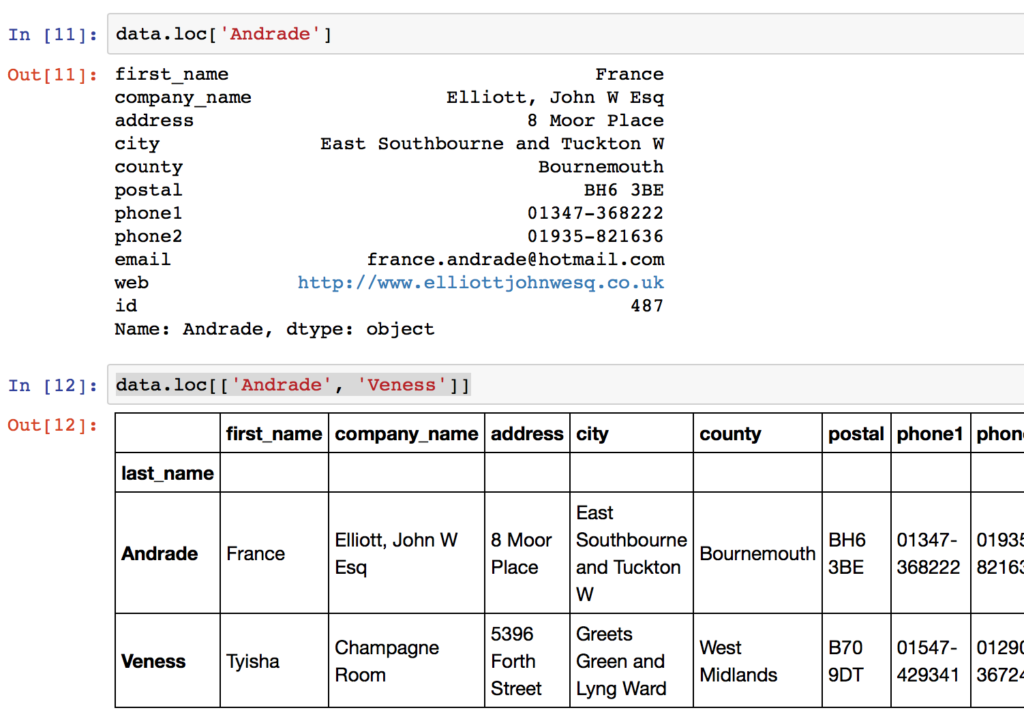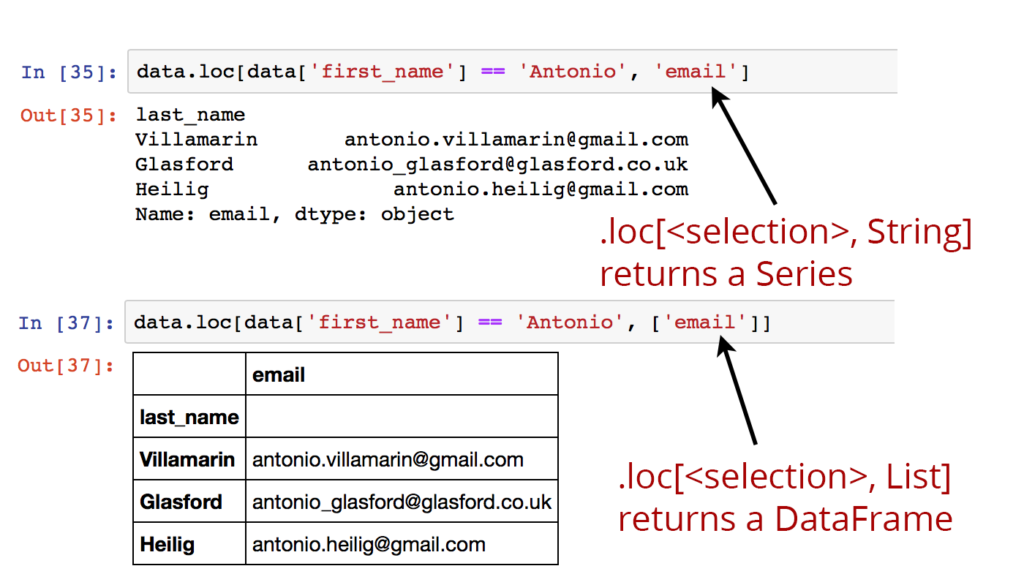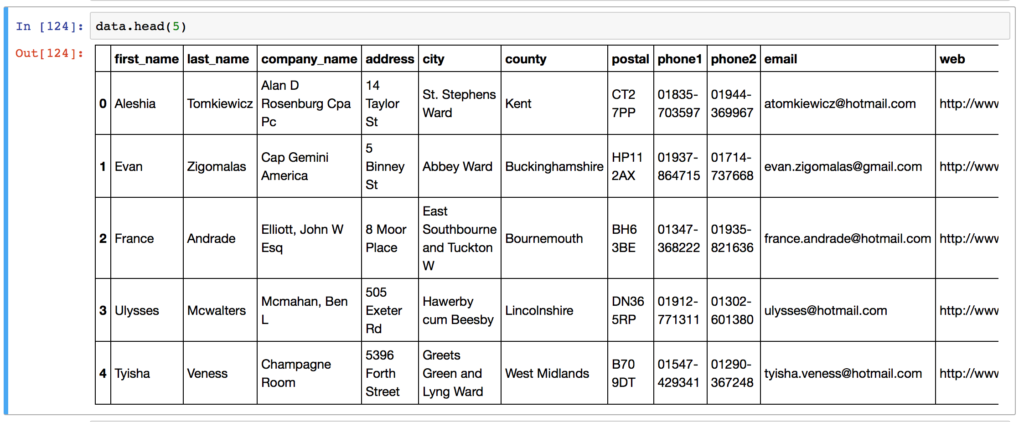Pandas Data Selection
There are multiple ways to select and index rows and columns from Pandas DataFrames. I find tutorials online focusing on advanced selections of row and column choices a little complex for my requirements, but mastering the Pandas iloc, loc, and ix selectors can actually be made quite simple.
Selection Options
There’s three main options to achieve the selection and indexing activities in Pandas, which can be confusing. The three selection cases and methods covered in this post are:
- Selecting data by row numbers (.iloc)
- Selecting data by label or by a conditional statement (.loc)
- Selecting in a hybrid approach (.ix) (now Deprecated in Pandas 0.20.1)
Data Setup
This blog post, inspired by other tutorials, describes selection activities with these operations. The tutorial is suited for the general data science situation where, typically I find myself:
- Each row in your data frame represents a data sample.
- Each column is a variable, and is usually named. I rarely select columns without their names.
- I need to quickly and often select relevant rows from the data frame for modelling and visualisation activities.
For the uninitiated, the Pandas library for Python provides high-performance, easy-to-use data structures and data analysis tools for handling tabular data in “series” and in “data frames”. It’s brilliant at making your data processing easier and I’ve written before about grouping and summarising data with Pandas.

Selection and Indexing Methods for Pandas DataFrames
For these explorations we’ll need some sample data – I downloaded the uk-500 sample data set from www.briandunning.com. This data contains artificial names, addresses, companies and phone numbers for fictitious UK characters. To follow along, you can download the .csv file here. Load the data as follows (the diagrams here come from a Jupyter notebook in the Anaconda Python install):
1. Pandas iloc data selection
The iloc indexer for Pandas Dataframe is used for integer-location based indexing / selection by position.
The iloc indexer syntax is data.iloc[<row selection>, <column selection>], which is sure to be a source of confusion for R users. “iloc” in pandas is used to select rows and columns by number, in the order that they appear in the data frame. You can imagine that each row has a row number from 0 to the total rows (data.shape[0]) and iloc[] allows selections based on these numbers. The same applies for columns (ranging from 0 to data.shape[1] )
There are two “arguments” to iloc – a row selector, and a column selector. For example:
Multiple columns and rows can be selected together using the .iloc indexer.
There’s two gotchas to remember when using iloc in this manner:
- Note that .iloc returns a Pandas Series when one row is selected, and a Pandas DataFrame when multiple rows are selected, or if any column in full is selected. To counter this, pass a single-valued list if you require DataFrame output.

In practice, I rarely use the iloc indexer, unless I want the first ( .iloc[0] ) or the last ( .iloc[-1] ) row of the data frame.
2. Pandas loc data selection
The Pandas loc indexer can be used with DataFrames for two different use cases:
- a.) Selecting rows by label/index
- b.) Selecting rows with a boolean / conditional lookup
The loc indexer is used with the same syntax as iloc: data.loc[<row selection>, <column selection>] .
2a. Label-based / Index-based indexing using .loc
Selections using the loc method are based on the index of the data frame (if any). Where the index is set on a DataFrame, using <code>df.set_index()</code>, the .loc method directly selects based on index values of any rows. For example, setting the index of our test data frame to the persons “last_name”:
Now with the index set, we can directly select rows for different “last_name” values using .loc[<label>] – either singly, or in multiples. For example:

Select columns with .loc using the names of the columns. In most of my data work, typically I have named columns, and use these named selections.

You can select ranges of index labels – the selection </code>data.loc[‘Bruch’:’Julio’]</code> will return all rows in the data frame between the index entries for “Bruch” and “Julio”. The following examples should now make sense:
Note that in the last example, data.loc[487] (the row with index value 487) is not equal to data.iloc[487] (the 487th row in the data). The index of the DataFrame can be out of numeric order, and/or a string or multi-value.
2b. Pandas Loc Boolean / Logical indexing
Conditional selections with boolean arrays using data.loc[<selection>] is the most common method that I use with Pandas DataFrames. With boolean indexing or logical selection, you pass an array or Series of True/False values to the .loc indexer to select the rows where your Series has True values.
In most use cases, you will make selections based on the values of different columns in your data set.
For example, the statement data[‘first_name’] == ‘Antonio’] produces a Pandas Series with a True/False value for every row in the ‘data’ DataFrame, where there are “True” values for the rows where the first_name is “Antonio”. These type of boolean arrays can be passed directly to the .loc indexer as so:

As before, a second argument can be passed to .loc to select particular columns out of the data frame. Again, columns are referred to by name for the loc indexer and can be a single string, a list of columns, or a slice “:” operation.

Note that when selecting columns, if one column only is selected, the .loc operator returns a Series. For a single column DataFrame, use a one-element list to keep the DataFrame format, for example:

Make sure you understand the following additional examples of .loc selections for clarity:
Logical selections and boolean Series can also be passed to the generic [] indexer of a pandas DataFrame and will give the same results: data.loc[data[‘id’] == 9] == data[data[‘id’] == 9] .
3. Selecting pandas data using ix
Note: The ix indexer has been deprecated in recent versions of Pandas, starting with version 0.20.1.
The ix[] indexer is a hybrid of .loc and .iloc. Generally, ix is label based and acts just as the .loc indexer. However, .ix also supports integer type selections (as in .iloc) where passed an integer. This only works where the index of the DataFrame is not integer based. ix will accept any of the inputs of .loc and .iloc.
Slightly more complex, I prefer to explicitly use .iloc and .loc to avoid unexpected results.
As an example:
Setting values in DataFrames using .loc
With a slight change of syntax, you can actually update your DataFrame in the same statement as you select and filter using .loc indexer. This particular pattern allows you to update values in columns depending on different conditions. The setting operation does not make a copy of the data frame, but edits the original data.
As an example:
That’s the basics of indexing and selecting with Pandas. If you’re looking for more, take a look at the .iat, and .at operations for some more performance-enhanced value accessors in the Pandas Documentation and take a look at selecting by callable functions for more iloc and loc fun.


![Pandas Dataframe with index set using .set_index() for .loc[] explanation.](https://c8j9w8r3.rocketcdn.me/wp-content/uploads/2016/09/index_set_dataframe-1024x497.png)
Thanks for going straight to the point.
Part 1:
data.iloc[:,1] # second row of data frame (last_name)
data.iloc[:,-1] # last row of data frame (id)
row should be column?
You’re absolutely correct Shucai. I’ll fix that ASAP and thanks for the spot!
[…] For more details: http://www.shanelynn.ie/select-pandas-dataframe-rows-and-columns-using-iloc-loc-and-ix/ […]
It was really helpful!
I’m glad you found it so Sujith! Thanks for the comment.
Awesome post! I was struggling with pandas for a few days already and then I found your post, it really is the missing manual for pandas selectors that helped me understand it all. Much appreciated!
Hi there! Much easier to understand than the pandas documentation.
I’ve got a question though, the answear to which eludes me despite trying to get through the documentation and hours of searching.
Is it possible, using .loc to exclude the line numbers and column headings from the output?
Cheers!
Hi Lisa. Glad you found it useful. Pandas data frames usually have column headers. You can reset indices using reset_index and maybe get rid of columns by changing to a numpy matrix using as_matrix I think.
Hi Shane,
Thanks for the post. However, I have a small doubt. In the following line of code:
data.iloc[[0,4,7,25], [0,5,6]] # 1st, 4th, 7th, 25th row + 1st 6th 7th columns
Shouldn’t it be:
data.iloc[[0,3,6,24], [0,5,6]] # 1st, 4th, 7th, 25th row + 1st 6th 7th columns
Considering that the indexing in Python starts from 0? Please correct my understanding on the same. Also, if you could also provide some more examples on .ix it would be great 🙂
Hi! You’re spot on there – that’s a massive misprint by me. I will update pronto! Thanks for spotting it.
As for ix – its mainly in the Pandas API for legacy reasons as I understand things – you are almost always better off being explicit and using iloc or loc for selection.
Hi Shane,
I have one problem. I want to subset my dataframe on the basis of indexes. I have dataframe of 52 observations.
I have two tuples :
inc
Out[248]: [1, 24, 39]
tot
Out[249]: (14, 37, 52)
Now i want to subset my dataframe by picking indexes from these two tuples. See following
first subset should be : inc[0] , tot[0] which would be (1,14)
second subset should be : inc[1] , tot[1] which would be (24,37)
third subset should be : inc[2] , tot[2] which would be (39,52)
Can you please help ?
Thanks in advance!!
BR,
Jagroop
Great post, thanks for the examples.
Thanks for a clear presentation, Shane. Is there a way to index on two columns? E.g. in your example some entries might have the same last name, and therefore not unique. Could the index be both last and first names?
Hi Dave. Good question, and I probably should have mentioned more about this. You can definitely select based on two or more different columns using logical operators. For e.g.:
data.loc[(data[‘first_name’] == ‘Shane’) & (data[‘last_name’] == ‘Lynn’)]
will work well. Just make sure you have the parentheses ()!
Thanks for your post.
I think the panda systax is very confusing, and this structured presentation is very helpful.
When I use multiindex in columns o rows, it is impossible for me to adivine the correct syntax.
Do you plan ton write a new post about selecting columns and rows working with multiindex dataframas?
Thanks again for sharing your work
Hi Vicente, I think you’re not alone with struggling to get to grips with the syntax at the start – there’s definitely some practice needed. I actually am planning a multi-index post, because I think this is an issue for people.
[…] the end of this section, I would like to give a little tip of the hat to a blog post on Shane Lynn’s blog that summed up the above in a nice little […]
Just found your blog and can’t thank you enough for it!
Very Nice tutorial for the first time in my life I come to know the difference between .iloc, .loc and .ix
Awesome post about iloc vs. loc Shane!
Interesting: for ML/DL, we use iloc all the time while you rarely use it.
hi Shanelynn, Thanks for this article. after reading the possible ways to use iloc, i was able to index the entire column from csv to make new with exactly the same size. thanks and keep up
[…] Use iloc, loc, & ix for DataFrame selections […]
Refreshingly clear. Nice job. Don’t stop. 🙂
Thanks!
This one helped me a lot, its comprehensive, Thanks a lot
I use df.at[str1=row label,str2=column name]
The best post i have read by far on the loc and iloc, Crisp and clear, straight to the point.
This is a great guide many thanks for sharing!
Regards,
James
Thanks, great post! Just wondering is there any difference between . loc and this approach?
df[df[‘column_name’] == ‘value’]?
From my understanding, I don’t think so – this is effectively a .loc selection with a binary vector to choose the columns, which should have the same effect.
Just great stuff
Can you explain this?
df6 = pd.read_csv(‘py_all1a.csv’) # file with multiple columns
df7 = pd.read_csv(‘artexclude1.csv’) # file with multiple columns
mask = df6.iloc[:,1].isin(df7.iloc[:,8]) #csv df6 col1is the same as col 8 in df7; I want to mask rows in df6 that have any
# matching col value in df7
df6[~mask].to_csv(‘py_all1b.csv’, index=False) # I tried this with (empty result) and without the tilde (no change to df6)
What am I missing?
Can you confirm the contents of the ‘mask’ variable – use mask.value_counts() – i.e. is the boolean index being calculated correctly?
Hi – is there a way to select non-continuous and continuous rows/columns by index? For instance, say I want to select columns 1, 2, and 4 through 19. Could I do that in one line?
Hi there. So yeah, that’s possible, you need to hand a list with the index values into the iloc selector. The key is in concatenating the lists to form the selections you want.
For example, try:
data.iloc[, [1,2] + list(range(4, 20))]
Very useful and helpful! Many thanks!
[…] https://www.shanelynn.ie/select-pandas-dataframe-rows-and-columns-using-iloc-loc-and-ix/ […]
That was helpful!
[…] Using iloc, loc, & ix to select rows and columns in Pandas DataFrames […]
[…] https://www.shanelynn.ie/select-pandas-dataframe-rows-and-columns-using-iloc-loc-and-ix/ […]